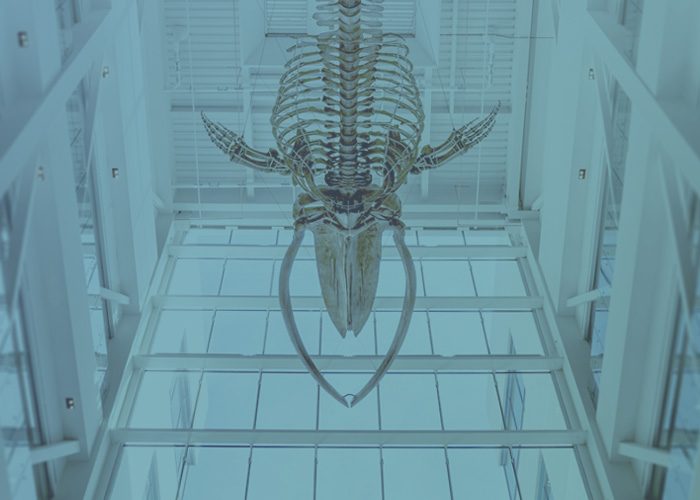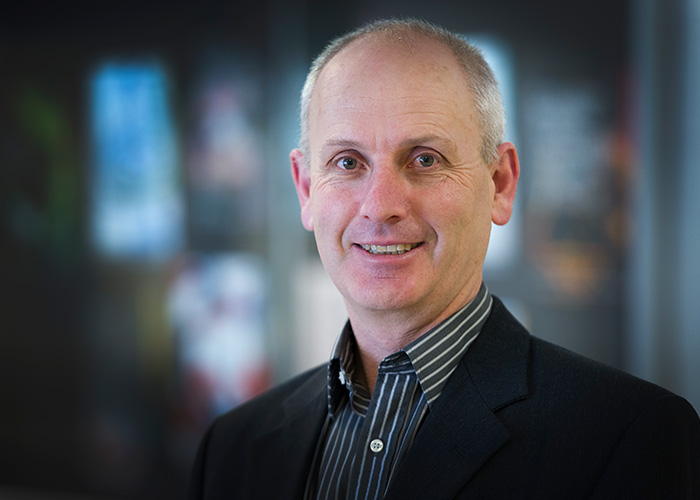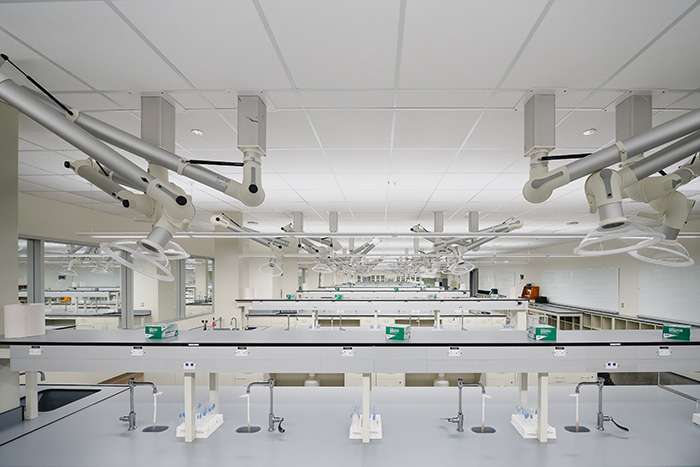THE NEXT 100
By Lisa Pendergast, B.COMM.(CO-OP.)’06, MBA’15

LIKE AN ICEBERG in the middle of the Atlantic – all white panels and sparkling glass, composed of three tower block pavilions, two vertical atria spaces and with a total surface area approximately the size of two NFL football fields – Memorial’s new Core Science Facility (CSF) stands strong on the St. John’s Campus.
The vision of HOK and Hearn/Fougere Architecture Inc., for this, the largest infrastructure project at Memorial since 1961, was inspired by the rugged environment that makes up Newfoundland and Labrador. And much like an iceberg, its real strength lies beneath the surface that is unique.

THE VISION
In 2008, Dr. Mark Abrahams was recruited as Memorial’s incoming dean of science and was asked to lead the initiative to construct a research building. His first step was to tour the Faculty of Science’s current spaces.
It became clear that the infrastructure need extended throughout all aspects of the faculty,” said Dr. Abrahams. “I noted significant safety issues in many teaching and research laboratories.– Dr. Abrahams
“It became clear that the infrastructure need extended throughout all aspects of the faculty,” said Dr. Abrahams. “I noted significant safety issues in many teaching and research laboratories. The provincial government provided $13.5M to address these issues, but like many renovation projects, once we opened up walls, new problems would appear. These projects were coming in at 30 times our estimated value – the point at which a new building made more economic sense.”
Dr. Abrahams had a vision for this facility that was shaped by two different experiences, the first being when he found himself on strike as a young faculty member at the University of Manitoba.
“During the strike, I had the opportunity to interact with faculty in a wide range of disciplines that I likely would never have met,” he recalls. “I found these conversations provided me with new perspectives on research and teaching that I would not have enjoyed under ordinary circumstances.”
The second was after Dr. Abrahams arrived at Memorial and spoke with a faculty member who was receiving a young investigator award.
“One particular technical struggle had delayed his research by about a year. During the questions, a faculty member who worked in the same building but on a different floor said that they had the same problem but found a solution years earlier,” he said. “Both these experiences drove home the message that any new building needed to promote communication among people throughout the building, and across as many disciplines as possible.”
THE CLIMB
With a project of this magnitude, there would be obstacles to overcome. The first of which was doubt that this building would ever be constructed.
“I learned that there had long been a plan to build a new science building,” said Dr. Abrahams. “So one of the first struggles was getting people to take this project seriously. This was very difficult in 2009, but became less so once construction began.”
The most significant struggle was to get funding. Next were complications with the tender process and timing of the project. The major construction tender was cancelled in July 2016 because bids received were higher than expected. This was a major setback – which did not help skepticism about the project – resulting in a 12-month delay. The main construction contract was eventually awarded to Marco Services Limited, that also had to contend with the pandemic delay.
On a positive note, due to the professionalism and hard work of the teams in Facilities Management and the Project Management Office, the project was completed in August 2021, within the global project budget of $325 million. With an infrastructure project of this magnitude, it was extremely important that it come within budget. Memorial contributed $200 million: $25 million from the Memorial University Matching Fund and $175 million from a borrowing program. The Government of Canada, through its New Building Canada Fund, provided support of $99.9 million with the remaining $25.1 million provided by the Government of Newfoundland and Labrador.
THE GRAND OPENING
November 26, 2021 was celebration day. In a ceremony attended by members of the provincial and federal governments, along with Lieutenant Governor Judy Foote (BA(Ed.)’74, B.Ed.’83) and university leaders, the new building was officially opened.
Faculty, undergraduate and graduate students, mostly from the Faculty of Science and Faculty of Engineering and Applied Science began teaching and learning in this space in September 2021.
Special features of the building include a computer lab with its own firewall, enabling engineering and science students to practise cybersecurity. Another lab has been designed for robotics and drone research. These learning spaces have been configured so that students and researchers can learn individually or collaboratively, while being able to enjoy views of the outdoor spaces through walls of windows – when we are not shrouded in fog!

“The building also includes shell space (unfinished locations) to use either as a form of institutional support for major grant applications, or to attract external users to campus,” said Dr. Abrahams. “This space was effectively used for the Canada First Research Excellence Fund that created the Ocean Frontier Institute and was awarded jointly to Memorial University in partnership with Dalhousie and the UPEI.”
Oishi Hawlader is a fourth-year biochemistry student. After working in older labs at Memorial, she is impressed with the new facilities in the CSF.
“Since our first year, we’ve been so excited, to hear about the new science building,” she said. “Coming to this modern facility, you feel the fresh sense of innovation – it is somewhere that you want to be. It will have a huge impact by attracting incredible students and faculty.” Her favourite feature is the open space and flow of the work areas – one of the original visions for this facility.


“Previously we had little rooms for each lab. Now each professor has their own section in a much larger open space that allows for so much communication,” she said. “Not only are you interacting with those in your specific field, you are also networking with everybody in the department. There is opportunity for collaboration, supporting each other and learning from others’ expertise, methods and techniques.”
It is also impossible not to notice the 25-metre-long skeleton of a blue whale, suspended in the atrium of the CSF. It’s a showstopper – an inspiration to all who enter the building, and a reminder of the importance of our oceans and protecting our marine life and their ecosystems.
This incredible tribute is only possible due to the initiative of Mark (B.Comm.(Co-op.)’81) and Sandra Dobbin (B.Sc.’94), along with Lisa and Craig Dobbin (BA’89), who generously donated $220,000 towards the restoration and installation of this blue whale in the CSF, in honour of Mark and Craig’s mother, Eleanor “Penney” Dobbin.
Although the tragic circumstances of having been caught in heavy pack ice brought the blue whale skeleton to us, we honour and celebrate its life and appreciate the rare learning opportunity it provides.

Alumna Lisa Browne (BA’91, MBA’93) became Memorial’s first vice-president (advancement and external relations) in August 2021.
She recognized the opportunity to highlight Memorial’s leadership position regarding our oceans, following the grand opening of the CSF, which aligns with the United Nations Decade of Ocean Sciences for Sustainable Development from 2021–2030. Over the next year, a number of events that showcase Memorial’s oceans expertise will take place in a celebration known as The Big Splash. The facility is meant to be explored and enjoyed by the people of Newfoundland and Labrador.
“We hosted Whale of a Day, which was a great opportunity to bring people to our St. John’s campus in a fun and demonstrable way,” said Ms. Browne. “Work on oceans happens across many disciplines. We are planning some new and exciting initiatives to highlight that. Hopefully this will encourage people who are interested in studying in these areas and to apply to Memorial when they reach university age.”
As a unique learning space that fosters collaboration, and is equipped with world-class laboratories, the CSF is a flagship for the university – inspiring our next generation of leaders and innovators.
“It’s a forward-looking building – not just the building itself, but everything that’s inside of it and the possibilities it represents. We recently announced new master’s degrees in software engineering, data science and artificial intelligence – that’s something I could only dream about when I was a student attending Memorial. As our 100th anniversary approaches in 2025, I’m reflecting on our first one hundred years. And I think this facility really signifies our next 100.”
We hosted an alumni family day, which was a great opportunity to bring people to our St. John’s campus in a fun and demonstrable way.– Lisa Browne


